
Hot Springs is a resort city in the state of Arkansas and the county seat of Garland County. The city is located in the Ouachita Mountains among the U.S. Interior Highlands, and is set among several natural hot springs for which the city is named. As of the 2020 United States Census, the city had a population of 37,930.

Malvern is a city in and the county seat of Hot Spring County, Arkansas, United States. Founded as a railroad stop at the eastern edge of the Ouachita Mountains, the community's history and economy have been tied to available agricultural and mineral resources. The production of bricks from locally available clay has earned the city the nickname, "The Brick Capital of the World". The city had a population of 10,318 at the time of the 2010 census, and in 2019 the estimated population was 10,931.
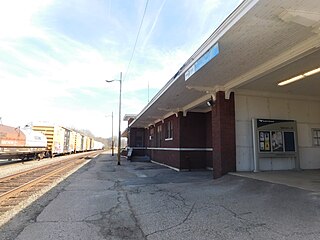
Malvern station is a train station at 200 E. First Street in Malvern, Arkansas. A former Missouri Pacific Railroad station, this 24-by-84-foot red brick depot was originally constructed in 1916. Amtrak's Texas Eagle serves Malvern with one daily passenger train in each direction. The station is unstaffed and, because trains stop on a flag stop basis, advance reservations are strongly recommended.

The Fort Smith Trolley Museum is a streetcar and railroad museum in Fort Smith, in the U.S. state of Arkansas, which includes an operating heritage streetcar line. The museum opened in 1985, and operation of its streetcar line began in 1991. Four vehicles in its collection, a streetcar and three steam locomotives, are listed on the National Register of Historic Places (NRHP). The now approximately three-quarters-mile-long (1.2 km) streetcar line also passes four NRHP-listed sites, including the Fort Smith National Historic Site, the Fort Smith National Cemetery, the West Garrison Avenue Historic District and the 1907 Atkinson-Williams Warehouse Building, which now houses the Fort Smith Museum of History.

Little Rock Union Station, also known as Mopac Station, is a train station in Little Rock, Arkansas, United States served by Amtrak, the national railroad passenger system.

Couchwood is the summer estate of Harvey C. Couch, an industrialist and founder of Arkansas Power and Light in the early 20th century. The estate, located at 601 Couchwood Road, is southeast of Hot Springs, Arkansas, straddling the border of Garland and Hot Spring counties on the north shore of Lake Catherine.

The Rusher Hotel, also known as the Great Southern Hotel, is a historic hotel building at 127 West Cedar Street in Brinkley, Arkansas. It was built in 1915 to serve the Brinkley Union Station. It is a three-story brick building, whose main entrance originally faced the railroad, but was reoriented to the street facade after the railroad declined in importance.
Hot Springs Historic District may refer to:
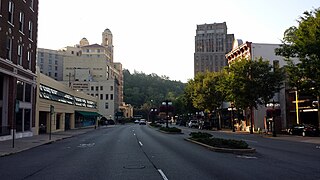
The Central Avenue Historic District is the historic economic center of Hot Springs, Arkansas, located directly across Central Avenue from Bathhouse Row. Built primarily between 1886 and 1930, the hotels, shops, restaurants and offices on Central Avenue have greatly benefited from the city's tourism related to the thermal waters thought to contain healing properties. Built in a variety of architectural styles, the majority of the buildings constituting the district are two- or three-story structures. The district was listed on the National Register of Historic Places in 1985, at which time forty contributing structures were identified; 101 Park Avenue was added in 2007, and a boundary decrease was approved in 2019.

The Siloam Springs Downtown Historic District encompasses the historic downtown area of Siloam Springs, Arkansas. The district is roughly bounded by University Street, Broadway, and Sager Creek, with a few buildings on adjacent streets outside this triangular area. This business district was developed mainly between about 1896, when the railroad arrived, and 1940, and contains a significant number of buildings dating to that period. It also includes Siloam Springs City Park, the location of the springs that gave the city its name. Notable buildings include the First National Bank building, a c. 1890 Romanesque Revival building, and the c. 1881 Lakeside Hotel, which is one of the city's oldest commercial buildings.
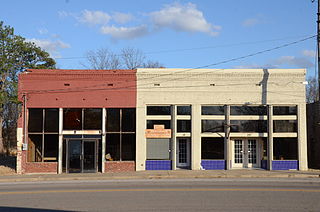
The Hartford Commercial Historic District encompasses about two blocks of buildings in the central business district of Hartford, Arkansas. Extending on the east side of Broadway from just north of Main Street to south of Ludlow Street, they are the only major commercial buildings left from Hartford's boom years of 1880–1920, when coal in the area was mined for use by the railroads. Most of the buildings are single-story brick structures, in typical early-20th-century commercial styles. Included in the district is Hartford's present city hall, which was built in 1910 as a theater.

The Fordyce–Ricks House Historic District encompasses a locally rare collection of Adirondack Architecture structures located at 1501 Park Avenue in Hot Springs, Arkansas. The district encompasses 37 acres (15 ha) of land that originally belonged to Samuel W. Fordyce, a prominent railroad executive who had a major role in promoting and developing Hot Springs as a resort community. The district includes a 1+1⁄2-story octagonal log house, three outbuildings, and a landscaped rustic environment. 20 acres (8.1 ha) of the former estate are now a part of Hot Springs National Park.
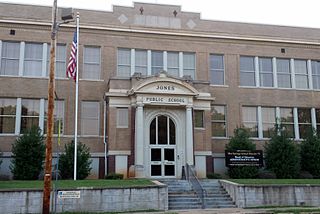
The Jones School is a historic school building at Linwood and Hobson Avenues in Hot Springs, Arkansas. It is a three-story masonry structure, finished in red and beige brick, with concrete trim elements. The building is an eclectic blend of Classical Revival and American craftsman styling, with Craftsman style window groupings and a Classical entrance portico. It was built in 1913, and now houses the Hot Springs School District administrative offices.
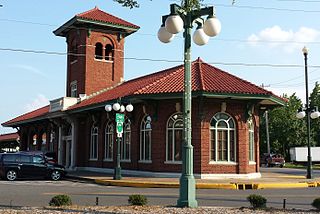
The Missouri-Pacific Railroad Depot-Hot Springs is a historic former railroad station at Broadway and Market Street in Hot Springs, Arkansas. It is a single-story masonry structure, roughly V-shaped due to the triangular parcel, with a tile hip roof with broad eaves supported by Italianate wooden brackets. A Tuscan tower rises above the station, and its walls consist of bays of compound round-arch windows. The station was built c. 1917 by the Missouri-Pacific Railroad, and is a major reminder of the importance of the railroad to the growth and success of Hot Springs as a resort community.

The Hot Springs Railroad Roundhouse is a historic railroad roundhouse at 132 Front Street in Malvern, Arkansas. Built in 1887, it is the last known surviving substantially intact roundhouse in the state. It has brick walls and a granite foundation, and houses five stalls. It was built by the Hot Springs Railroad as a service facility for its locomotives, and was used in that capacity until 1904. It has since seen use as a warehouse and manufacturing facility.

The Pleasant Street Historic Historic District is a historic district encompassing the historic African-American community area of Hot Springs, Arkansas. It is located just southeast of the city's famous Bathhouse Row area, centered on a four-block stretch of Pleasant Street between Jefferson and Church Streets. The 30-acre (12 ha) district includes 93 buildings, most of them residential. The area was developed between about 1900 and 1950, with most of the development taking place after 1920. Prominent non-residential buildings include the Visitor's Chapel A.M.E. Church at 317 Church Street, and the Woodmen of Union Building, a four-story brick building on the 500 block of Malvern Avenue.
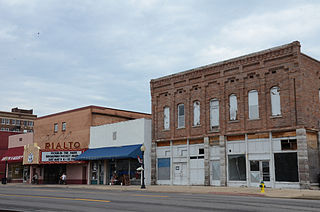
The Morrilton Commercial Historic District encompasses the historic central business district of Morrilton, Arkansas. The L-shaped district includes two blocks of East Railroad and East Broadway, between Division and Chestnut Streets, and three blocks of Division and Chestnut Streets, between Broadway and Vine. This area was mostly developed between 1880 and the 1920s, and was heavily influenced by the railroad, which passes between Broadway and Railroad. Prominent buildings in the district include the Morrilton Post Office, Morrilton Railroad Station, First National Bank of Morrilton, and the Coca-Cola Building.

The Porter Screen Company is a historic former industrial facility at 110 East Spring Street in Winooski, Vermont. Developed beginning 1910–11, this mill complex was an important secondary industrial employer in the city, shipping window screens and other housing parts nationwide. The facility, now converted to senior housing, was listed on the National Register of Historic Places in 1979.



















